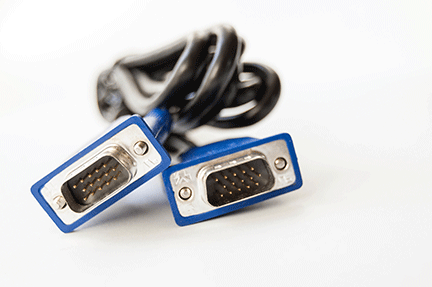In our last blog, I discussed the world of the USB connection and a little bit of background on the various types of interfaces you may see. Moving forward, we take a look at one of the early types of connections but one still found commonly on printers and industrial computers, the Serial port.
Disclaimer: The term “Serial” refers to a number of things in the world of electronics. For the purpose of this blog, the term serial will be referring to a DB-9 or DB-25 cable/port in the RS-232 standard.
Serial Connections
So where does the name come from? This has to do with how the serial port transmits data, essentially taking one bit of data at a time and transmitting it along a single wire (i.e. “serially”). The advantage is that it only needs the one wire to transmit the bit of data, allowing for a much longer cable to be used without interference issues. So what do these things actually look like?
Serial connections are typically seen as a nine pin or nine slot male and female connection, respectively. Shaped like a trapezoid, they also have left and right location for screws to securely fit one connection to another. These types of connections are typically found at the host (computer) device, however this is not always the case.
There is also a 25 pin serial connection and these are almost always located at the device (printer) and they look like their nine pin counterpart, however with more than double the number of pins or slots.
Please keep in mind that it is entirely possible for there to be a 9 pin connection at the host (computer) and a 25 pin connection at the device (printer) and this is a perfectly functional connection type.
So what does all this mean and why is it important? Having an understanding or a reference to these kind of connections and what they look like is crucial for getting your devices connected and working correctly. Many of these interfaces can look similar to one another but function in an entirely different way (as you will see in a later blog all about parallel connections). As always, if you are unsure of the connection you have or are looking for more information on this subject, please contact us and we will be more than happy to help you through this process.
*Future blogs to include parallel, PS/2, Ethernet and anything else I can think to add as this progresses*
About the Author:
 Brandon is a member of L-Tron’s Sales Team specializing in the webstore and inside sales rep duties. When he is not at work, you can find Brandon skiing, traveling or playing his guitar. You can reach Brandon at 800-830-9523, x116 or email Brandon.Morabito@L-Tron.com.
Brandon is a member of L-Tron’s Sales Team specializing in the webstore and inside sales rep duties. When he is not at work, you can find Brandon skiing, traveling or playing his guitar. You can reach Brandon at 800-830-9523, x116 or email Brandon.Morabito@L-Tron.com.













